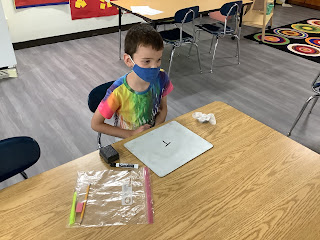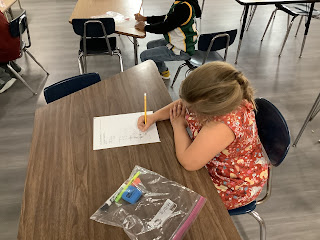Friday, October 8th: End of 1st Quarter
Thursday, October 14th: Yost Blood Drive
Wednesday, October 22: Fall Break - No School
Tuesday, November 2nd: E-Learning Day
 1st Grade: Concept of Connections
1st Grade: Concept of Connections
This week we started class with matching a game on connections. We had a talk about some might have more than one option, but to look for the pair with the strongest connection. This led us into a discussion of the generalizations of connections. We have three generalizations that guide our discussion on connections throughout the year.
- Connections show relationships among objects, ideas, places and people.
- Connections can be intellectual, physical, social, or emotional.
- Connections may change or stay the same over time.
We took some of our connections and walked slowly through these 3 guidelines as we defined the connections further. They are doing well with the first and the third one. We discussed that the second one is a little tricky. We also might need some more information based on each individual and the connection. We used a child to a stuffed animal. To one person the stuffed animal might not mean anything, but to another child it might be a very special stuffed animal that they have a strong emotional attachment with it. This helped them understand this further and how the more information we have for that one the easier it became. We ended the week looking at some black and white pictures and using our connections to discuss what they symbolized. This led into us discussing the Shield of Connection project that came home on Monday. We took a few minutes in class to discuss this project.
Next week we will create our own Shield of Connections!
More about the Shield of Connections
The goal is for the students to create 6 to 8 symbols of a personal connection for their shield of connections.
The image should be labeled with a number that will connect to their writing about each symbol.
The image should be in black and white.
The image should be a symbol of the connection that we might be able to guess the connection. If a student loves dogs, the picture should not be of a dog, but maybe a paw print, collar or bone.
Then, they complete the writing about each connection. Please make sure the number on the writing matches the patch they labeled with that number.
We will complete the project the rest of the project in class next week.
2nd Grade: Concept of Connections
This week the rest of the class finished presenting their connections project. I was excited to hear a few categories I haven't heard before with this group making their own personal connections to the list. Then we used some of those connections to guide us to the generalizations of connections. We have three generalizations that guide our discussion on connections throughout the year.
- Connections show relationships among objects, ideas, places and people.
- Connections can be intellectual, physical, social, or emotional.
- Connections may change or stay the same over time.
We took some time to walk through these items slowly. We would look at a connection and on whiteboards the students would identify the generalizations to that connection.
Next week will begin a new lesson.
3rd Grade: Generalizations to Change
This week we finished the sorting of our change and naming the categories. This led us into defining the generalizations to change. We took a few different examples to help us discover the 5 items.
We have 5 generalizations to change that will guide our discussions throughout the year.- Change is EVERYWHERE.
- Change happens at different rates.
- Change can be positive or negative.
- Change can be systematic or random.
- Change can be caused naturally or by humans.
They did a great job understanding the generalizations. To end the week, we looked at the quote below:
Aim for the stars. If you fall short, you will land on the moon. - by an unknown author
The students were given different options to present what this quote meant to them.
We will continue working with this project next week.
4th Grade: Generalizations to Change & Grammar Time
This week we wrapped up our lesson on defining change. We took some time to look at several examples of change as we developed our generalizations.
We have 5 generalizations to change that will guide our discussions throughout the year.
- Change is EVERYWHERE.
- Change happens at different rates.
- Change can be positive or negative.
- Change can be systematic or random.
- Change can be caused naturally or by humans
After gaining a strong understanding of our concepts to change we moved onto Grammar Time. We started out the year by identifying nouns and verbs. We needed a quick reminder to find only the noun and we do not include any adjectives. We discussed action verbs, helping verbs, and linking verbs.
We need a little more practice with our 3 types of verbs and will continue with that next week.
1st Grade: Polygons
This week we finished What's the Same About These Shapes. We looked at pentagons and quadrilaterals. We continued to identify the number of sides, vertices and angles for each of these shapes. Some of my students were struggling with shapes that have reflex angles, so we explored this concept further. To end the week, we played a shape game to review the different polygons we have studied. Next week we will continue gaining a strong foundation with these shapes.
*I am missing photos for this group this week because several of them were very blurry.
2nd Grade: Symmetry
This week the students were introduced to the concept of symmetry. To start the class, I saw that some of the students had a basic knowledge with symmetry. They knew it had to be the same on both sides. From there we took this idea further. We talked about it being the same on both sides when it is cut in half. This introduced them to the line of symmetry. We also discussed it being a mirror-image or that when you fold the shape the sides and vertices will align. To end the week, we also discussed what happens if there is a pattern on the shape that we are looking at to see if it is symmetrical. They seemed confident in knowing that the design must also be symmetrical. To work with symmetry the students completed several worksheets and then to end the week we went on a symmetry hunt around the room.
Symmetry Hunt
We will continue working with symmetry next week.
3rd Grade: The Name Game: Think Deeply
This week we continued playing the Name Game and studying repeating patterns. This week we really focused on the 3 ways to solve the problems. This introduced us to looking at long division. Then, we started to look at our first Think Deeply of the year. This year their Think Deeply looks different than in past years of high ability. 3rd and 4th graders are expected to write a full response on their own. They are asked a question and must answer and explain the steps to solve it. We finished our notes and had time to start our response.
More About the Think Deeply
When we complete a Think Deeply, we will walk through the question and take notes on the topic. The notes allow them to have ALL the materials they need to answer the question. The first few Think Deeply questions we complete we will walk through the response together. This is an opportunity for them to learn how to answer these questions. In a response, we are looking for them explain or teach what they learned from the lesson. I always tell them to think that I know nothing about the topic as they are writing their explanation.
We will finish our Think Deeply next week.
4th Grade: Zaccaro - Solving
This week we continued to grow their background knowledge with algebra before we begin our unit. We started to look at an algebraic problem and the steps to solve it. We discussed that the goal is to isolate the variable and get it to stand alone on one side of the equation. Plus, the rule to solving a problem of what you do on one side of the equation you must complete on the other side. This led us into working together to solve problems and walking through the steps. The biggest challenge is asking them to show their work. Right now, some of the problems are simple as we are just teaching the steps, but as we grow and work further in algebra it is important to show all their steps as they solve the problem.
We will begin our unit next week.
Ms. Losinski
 1st Grade: Concept of Connections
1st Grade: Concept of Connections

















































